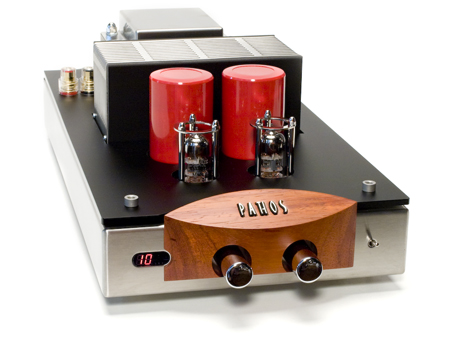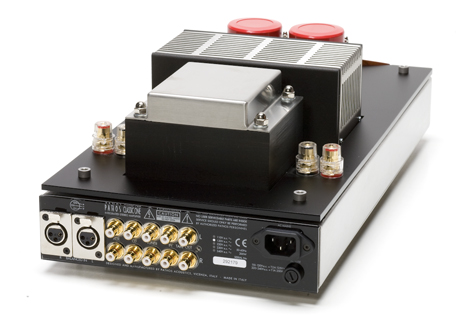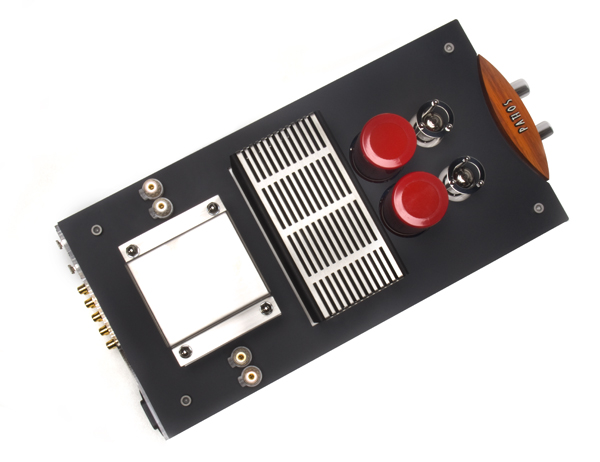 I’ve always been a fan of Pathos Acoustics fusion of Italian style with technology, while always yielding very musical results.
I’ve always been a fan of Pathos Acoustics fusion of Italian style with technology, while always yielding very musical results.
The Classic is the perfect integrated amplifier for someone wanting to integrate a compact, yet high performance music system into a design conscious environment. It is very reasonably priced at $2,995.
The ClassicOne mk. III has been part of the Pathos product lineup for some time now and is a solid seller, packing 70 watts per channel onto a very compact chassis that only measures 8” x 14” x 5” (90 x 100x90mm). Though there are five inputs on the rear panel, input one can be either balanced XLR or RCA, with the other three being RCA. There is also a fixed level RCA output to use for recording. I would love to see a variable level output for a subwoofer substituted here. I think this would be highly useful, as often times when a system has to be designed around the decor, a subwoofer/sattelite setup is called into play. Perhaps in the mk. IV?
Major Style Points
From the minute you take the ClassicOne out of the box, the attention to detail is apparent. The front panel is polished aluminum and sculpted wood, with a tiny power switch to the right and an LED display to the left, working double duty as a volume indicator and input selector. The transformer case is polished to a high gloss while the black plexiglass chassis top has a matte finish, something I felt was a nice touch, as it will not show fingerprints as readily as a gloss black surface. The very svelte remote control is made from solid wood and has four small buttons to control inputs, muting and volume.
No attention to detail has been spared on the ClassicOne. The allen head bolts on the top of the chassis are chrome plated along with the control knobs and the small tube cages guarding the pair of 6922 tubes in the preamplifier section. This is definitely a work of art that will get plenty of attention in your listening environment.
A true integrated
Unlike many amplifiers at this price point, the ClassicOne has a separate pre and power amplifier stage. Taking this approach is more costly to the manufacturer, but it does offer more linear volume control action as well as a stable input impedance. Many so called integrated amplifiers with a passive volume control tacked on the front of a power amplifier can be very source dependent, sometimes sacrificing dynamics or rolling off the high end somewhat. I had no problems using the ClassicOne with any of my reference components.
The output stage of the power amplifier is class AB solid state, with high bias current. This uses a few more watts of power, but results in a smoother sound throughout the range, with excellent bass control.
The System
Keeping with the design concept of the ClassicOne, most of my listening was done in the living room system, however to get a good feel for the performance envelope of the amplifier, I started out in the studio, using the GamuT S-7’s, Harbeth Monitor 40.1’s and MartinLogan Spires. Mating a $3,500 amplifier with considerably more expensive speakers is somewhat overkill, but it reveals the limits of the amplifier much easier.
Even as the heart of a $100,000 system, the ClassicOne did an excellent job. I also made it a point to compare it to a couple of my other favorite amplifiers in the three to ten thousand dollar range to see how it stacked up against its peers. Needless to say, I came away very impressed. Should you live with the ClassicOne for a while and decide you have to have more power, the ClassicOne can be bridged and used in mono mode, giving you a pair of very compact 150-watt amplifiers.
We managed to get a second ClassicOne for a brief period and the results were excellent. I’m not sure if I would build a system like this from the ground up, probably choosing one of Pathos larger power amplifiers instead, but the flexibility is a great idea.
Once a baseline feel for the ClassicOne’s performance was established, I moved it back to the living room system, with the highly efficient Zu Audio Presence speakers. This was a great match, because the Zu speakers high sensitivity gave the ClassicOne almost unlimited headroom.
The system was rounded out with the BelCanto CD1, which has a similar form factor to the ClassicOne, though I’m sure if you were starting from scratch, you’d probably want to go with the Pathos Digit CD player – it matches the aesthetics of the ClassicOne perfectly.
Shunyata Venom cables and their VRay power conditioner took care of the power duties with Empirical Design 422 interconnects and 213 speaker cables made up the rest of the system. All told, I had assembled an extremely satisfying system for just over $10,000.
The Sound
The hybrid concept of the ClassicOne succeeds brilliantly, truly combining the benefits of both technologies. The overall tonal balance is slightly warm, yet it has the grip of a good solid-state amplifier. When listening to “The Barbarian” on Keith Emerson’s current album, the tiny Pathos amplifier took hold of the GamuT’s woofers and shook the room accordingly, with the low synth bass notes on “Ignition.”
Thanks to the ClassicOne’s rich sound, the female vocal lovers in the audience will be extremely happy. Those of you that live on a steady diet of this kind of music will love the way this amplifier gives solo vocalists a larger than life presentation. Spinning Jacqui Naylor’s Live at the Plush Room, 2001 put her center stage, about six feet in front of the equipment rack. It’s worth noting here that the ClassicOne makes an outstanding combination with the Focal Utopia Diablos that we reviewed last issue. The warmth of the Pathos with the high resolution of the Diablos convinced many visitors to my home that they were listening to a much more expensive system.
Those two tubes give this amplifier something special, offering a slightly lush, airy presentation that I think will bring out the best in source components that are similarly priced. It’s also worth noting that the ClassicOne offers one balanced input, so this will give you a lot more flexibility when choosing source components. Many of today’s newer DAC’s have balanced outputs, so this is handy, if you want to put the Pathos amp front and center, yet have your DAC and perhaps a music server elsewhere in your listening room.
The ClassicOne’s slightly forgiving nature was also a huge blessing when streaming audio from the Internet, or using the iPod as a source. The 320kb/sec feed from the Zune Pass on our living room’s HP Touch Smart music server sounded the best I’ve ever heard from a low-resolution source.
When we stepped up the game a bit and played some high res files from the Naim Label, and the B&W Music club through the Wadia 521 DAC, the ClassicOne had the necessary resolution to showcase the format.
On all but the most inefficient speakers, I had to press the ClassicOne way beyond reasonable levels to drive it to clipping (and again, you can add the second amp if you have to play that loud), even with the Harbeth 40.1’s which have a low sensitivity of 86db.
Conclusion
Overall the Pathos ClassicOne mk.III is one of those rare components that achieves a perfect balance of performance, style and value. Thanks to the small tube compliment, you will not have to worry about sourcing tubes, either. The 6922 and it’s variants are very plentiful at reasonable cost, and I don’t imagine the ClassicOne going through tubes in a hurry, so probably a new pair every five years or so should keep you running along just fine.
Whether you are a mega audiophile putting together a second system, or a music lover that doesn’t want to sacrifice aesthetics for performance, this amplifier will keep both sides of your brain very happy.
UPDATE: 10/2019
Kevin Deal from Upscale Audio/Upscale Distribution has taken over as the new North American distributor for Pathos products, and we are excited so see a true qualityphile and tube guy distributing this fine product. Here’s Kevin’s quick take on having the line:
“I have always loved Pathos. In Europe, Pathos enjoys an incredible reputation for both sound and build quality, and they are very popular. Their previous U.S. importers were not deeply technical. They sold it as being beautiful, which it is, but the real beauty is on inside. Everything is made in-house in Vicenza Italy. Even the remotes are machined at the factory. They make the best hybrids on the market. They have real chops, and we are super excited.”

The Pathos ClassicOne Mk. III
MSRP: $3,195
North American Distributor
Upscale Audio/Upscale Distribution
2058 Wright Avenue
La Verne, California
909-931-9686
Peripherals
Digital Sources BelCanto CD3, Wadia 521 DAC, Luxman DU 7i combination player
Speakers Harbeth Monitor 40.1, Gamut S-7, Focal Utopia Diablo, Zu Audio Essence
Cable ED Design 213 and 422 (speaker and interconnect)
Power Shunyata VRay power conditioner, Shunyata Venom power cords














